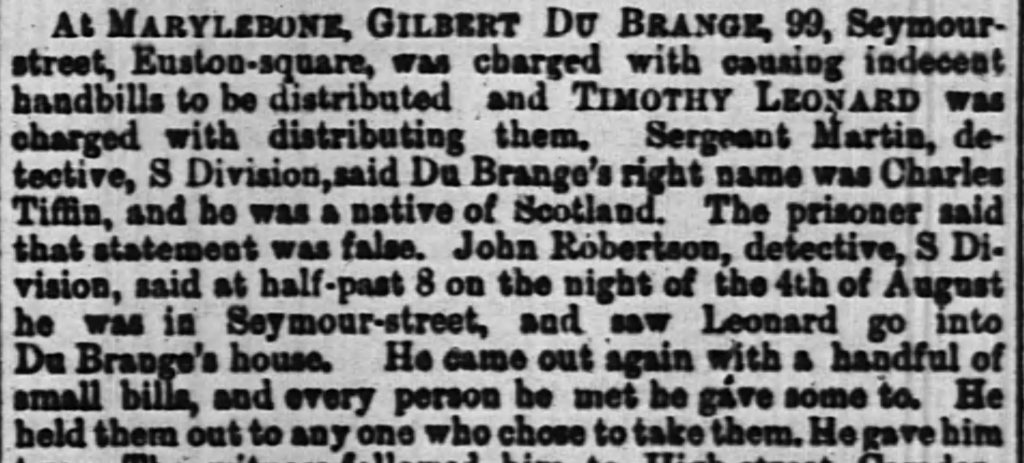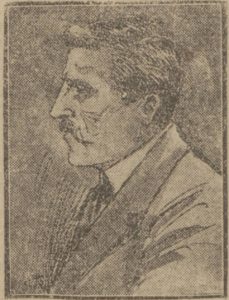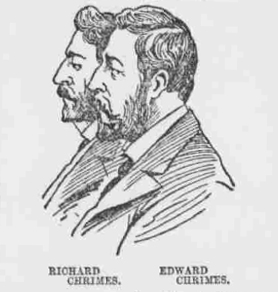While researching in the British Newspaper Archive, Kilburn historians Dick Weindling and Marianne Colloms discovered a practitioner with the unusual name of Du Brange. They were intrigued to find that he appeared in court several times. I’m intrigued too, as Du Brange has a lot of similarities with other London medical advertisers I’ve studied – especially Drs Henery, Hammond and De Roos, who appear in chapter 5 of The Quack Doctor.
Dick and Marianne have kindly given me permission to reproduce the beginning of their article – to read more about Dr Du Brange, visit their blog, Kilburn and Willesden History.
Indecent handbills
The first time that he is shown in the newspapers was in October 1869 when Gilbert Du Brange of 99 Seymour Street, Euston Square, (which is now called Eversholt Street), was charged in the Marylebone Police Court with causing indecent handbills to be distributed by Timothy Leonard.
Sergeant Martin, a plain clothes detective of S Division, said they’d been observing Du Brange for some time and that his real name was Charles Tiffin, a native of Scotland. Du Brange said this was a lie. Another detective, John Robertson, said he was in Seymour Street at 8.30pm on the 4th August and he saw Timothy Leonard go into Du Brange’s house. He came out again with a handful of small bills and he gave one to every person he met. He gave two to Detective Robertson who followed him as far as Camden High Street. Here Robertson took Leonard’s name and address, which turned out to be false and he was later apprehended on a warrant. On 20 Oct Detective Robertson went to Du Brange’s house. Eventually du Brange admitted he had asked Leonard to distribute the bills. He said he also gave out handbills under the railway arch at Camden Town when Du Brange had gone there to lecture about the medicinal properties of his pills. Detective Martin said Tim Leonard had told him he was paid 1s 6d a day to hand out the bills.

Du Brange said he was well known and he had been selling pills in the open air for about two or three year until about nine months ago when his business had increased and he stayed in his shop. When he sold a box of pills he wrapped them in a handbill to advertise his products. When he sold them to a woman he wrapped them in plain paper. He said he sold about three or four gross of pills every day. The magistrate asked if he was a qualified medical man. Du Brange said he was a graduate of medicine from Giessen, Germany. The court clerk explained that anyone could get a diploma there for 10s. The police said that from their enquiries Du Brange was not in any way connected with the medical profession and the case was brought under the Metropolitan Streets Act of 1867, a section of which prohibited the distribution of handbills.
The magistrate concluded there were no doubts about the case and Du Brange would pay a penalty of 40s and Leonard 10s or they would be imprisoned for 14 days and seven days respectively. Du Brange paid the fines and said the case would be his ruin.
Following the report in The Times, Dr Wilbrand of the University of Giessen in Germany, wrote a letter to the editor saying they were repeatedly been accused of selling diplomas of medicine. This was not true and neither Charles Tiffin or Gilbert Du Brange was a graduate of the University.
It’s clear that the bad publicity didn’t stop Du Brange from peddling his pills. To find out more about him and his career, continue reading at Kilburn and Willesden History.





One thought on “The mysterious Doctor Du Brange”
Comments are closed.